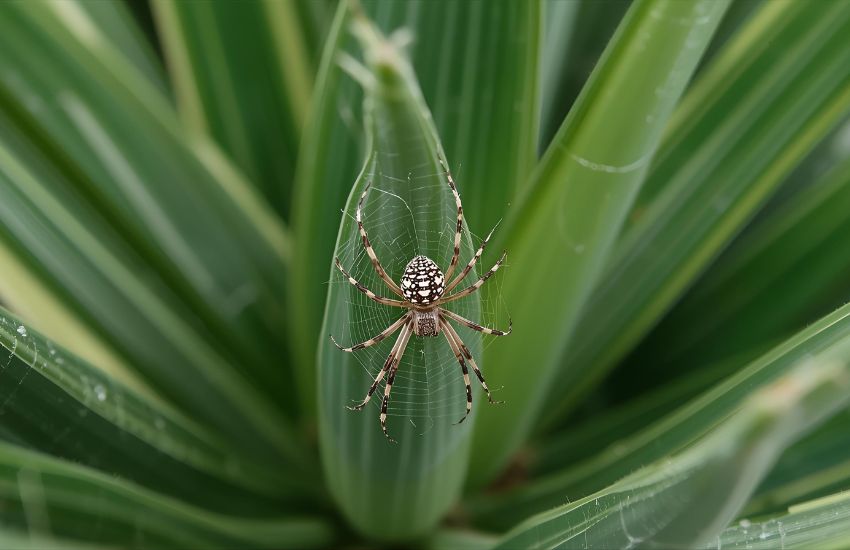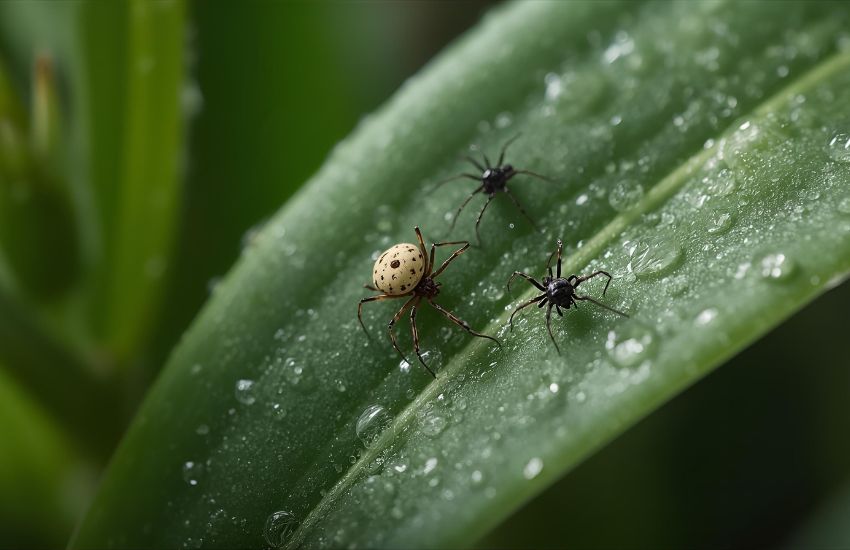Tiny specks on your spider plant’s leaves may seem harmless until they multiply, spin delicate webbing, and drain the life from your greenery. If you’ve noticed fine web strands, yellowing foliage, or unusual leaf discoloration, you’re likely dealing with a spider mite infestation. These microscopic pests, though often mistaken for insects, are arachnids and can damage plants rapidly, especially under dry conditions. To save your spider plant, early detection and proper treatment are essential.
To spot spider mites, check the undersides of leaves for fine webs, yellow discoloration, or tiny moving specks. Treat infestations by spraying neem oil, insecticidal soap, or water regularly. Isolate affected plants and maintain humidity to stop the spider mite spread quickly.
Knowing how to control spider mites starts with understanding their behavior. These pests thrive on the undersides of leaves, feeding on cell sap and causing visible speck patterns and curling. You’ll learn how to identify the signs, prevent the spread, and use treatments like neem oil, insecticidal soap, or even water sprays to bring relief to affected plants. Since mites are not insects, traditional insecticides may be ineffective, making targeted solutions critical.
In this guide, you’ll discover how to identify a spider mite problem, treat a severe infestation, and protect your plant using methods that won’t harm the soil, beneficial insects, or your indoor space. Let’s dive into practical, effective ways to spot, treat, and prevent future outbreaks before the damage becomes irreversible.
Early Signs of Spider Mite Infestation on Spider Plants

Recognizing the early signs of spider mite infestation on your spider plants can make the difference between a quick recovery and a stressed, struggling plant. One of the first indicators that spider mites are present is the appearance of fine webbing, particularly around the undersides of leaves or where the leaf meets the stem. Though tiny and often hard to spot without a magnifying glass, mites can be found crawling in these delicate silk threads, especially in heavy spider mite outbreaks.
As the mite populations increase, you’ll begin to notice changes in the foliage. Mites suck the plant’s fluids, leaving behind pale dots known as stippling of leaves. These spots often start as small yellow specks and gradually turn into larger areas of spider mite damage, including browning, curling, or total leaf drop. The two-spotted spider mite—one of the most common culprits leaves telltale signs, including both fine webbing and visible feeding marks.
Because mites thrive in hot, dry environments, early identification is key to prevent spider mites from spreading. Using predatory mites, predatory insects and mites like Amblyseius, and maintaining humidity are parts of an effective control strategy. The earlier you act, the easier it is to rid of spider mites and restore your plant’s health. Check the undersides of leaves often and keep a spray bottle on hand to respond quickly when spider mites are present even though they’re related to spiders, they require a completely different approach.
How to Prevent Spider Mites on Spider Plants for Good

Preventing spider mites on your spider plants requires a proactive, well-informed approach that protects both the foliage and overall plant growth. These tiny garden pests, recognizable by their eight legs as adults, can cause significant damage if left unchecked. Fortunately, you can take several sustainable steps to ensure your ornamental plants remain healthy year-round.
Monitor and Inspect Regularly
Early detection is crucial. Shake a leaf over a white sheet of paper if you notice tiny specks moving around, you may be witnessing the first sign of their presence. Because young mites emerge with six legs and develop their last two after they hatch, ongoing inspection is essential. Mites prefer feeding on the sap of tender plant parts, including the stem and undersides of foliage.
Increase Humidity and Air Circulation
Spider mites thrive in dry, stagnant conditions. Keep humidity levels higher around your plants and ensure proper airflow. This discourages egg-laying and slows reproduction, as eggs hatch in just 5–7 days under ideal conditions.
Use Safe, Targeted Treatments
Avoid using pesticides that risk harming beneficial insects. Instead, opt for horticultural oils or insecticidal soaps applied thoroughly and frequently until the problem is under control. Always follow label directions to avoid damaging the plant.
Introduce Natural Predators
Biological control is both sustainable and effective. Natural predators like Phytoseiulus persimilis, Californicus, and other predatory mites can help control spider mite populations. These predators do not harm your ornamental plants and help restore balance without chemicals.
Conclusion
Protecting your spider plants from spider mites begins with vigilance and ends with consistent, informed care. From spotting fine webbing and early spider mite damage to using safe treatments like neem oil, insecticidal soaps, or introducing natural predators, each step you take plays a vital role in breaking the pest cycle. Remember, spider mites are present most often on the undersides of leaves, where they feed on plant sap and rapidly multiply especially in dry conditions. Addressing even the first sign of their presence can stop an infestation before it becomes severe.
By maintaining healthy humidity levels, avoiding harmful chemicals, and integrating predatory insects and mites such as Phytoseiulus persimilis and Californicus, you not only manage existing issues but also effectively prevent spider mites from returning. Whether you’re shaking leaves over a white sheet of paper to detect activity or using a spray bottle for routine care, every effort supports long-term plant vitality.
Stay observant, act early, and make spider mite prevention part of your regular plant routine. Take action today to ensure your spider plant stays lush, resilient, and completely free from these destructive garden pests.
Frequently Asked Questions (How to Spot and Treat Spider Mites: Save Your Spider Plants Fast)
How to get rid of spider mites on plants fast?
To get rid of spider mites quickly, spray affected plants with a strong stream of water to remove them, then use insecticidal soap or neem oil on leaves, especially undersides. Repeat every 3–5 days, isolate infested plants, and maintain high humidity to prevent re-infestation.
What is a natural killer for spider mites?
A natural killer for spider mites is the predatory mite, such as Phytoseiulus persimilis. These tiny beneficial insects feed exclusively on spider mites, controlling their population without chemicals. Ladybugs, lacewing larvae, and neem oil also help reduce infestations naturally, keeping plants healthy and pest-free.
Can you save a plant with spider mites?
Yes, you can save a plant with spider mites by isolating it, thoroughly spraying with water to remove mites, using insecticidal soap or neem oil, and maintaining high humidity. Regularly check and treat until mites are gone, ensuring the plant recovers fully with proper care and nutrition.
How do I get rid of mites asap?
To get rid of mites quickly, isolate the affected plant immediately. Spray it thoroughly with a mixture of water and mild insecticidal soap or neem oil, ensuring all leaves are covered. Repeat every 3–5 days, clean surrounding surfaces, and maintain proper humidity to prevent re-infestation.
